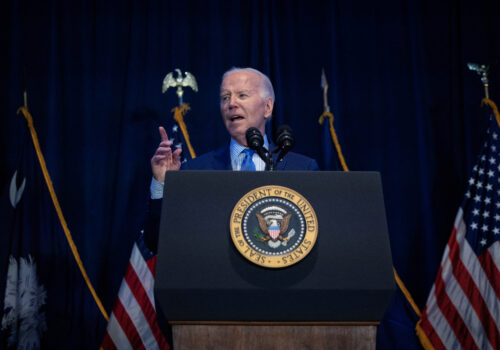Experts react: US retaliation for the deadly attack in Jordan has begun. What’s next?
Prepare for round two. On Sunday, John Kirby, a spokesperson for the National Security Council, said that US strikes over the weekend in Iraq and Syria were “just the first round” in response to the January 28 killing of three US servicemembers in a drone attack in Jordan. He spoke after B-1 bombers and other US forces conducted more than eighty-five strikes against targets linked to Iran’s Islamic Revolutionary Guard Corps (IRGC) and Iranian proxies. So what message is the United States sending to Iran and other countries in the region with its ongoing response? And what’s coming next? Our experts are in the ring.
This post will be updated in the coming days as the US response continues to unfold.
Click to jump to an expert analysis:
Abbas Kadhim: The US shows Iran that the loss of American lives is a clear red line
Nathan Sales: To make Iran stop, the US must impose more meaningful costs
Carmiel Arbit: Israel wants the US to take a more forceful approach against Iran
The US makes the case for escalation dominance—without giving Iran justification to respond
The recent US strikes in Iraq and Syria represented the most significant series of US military strikes in the region for the Biden-Harris administration to date. The US strikes were probably the minimum level for an initial US response to the Iranian proxy group attack against Tower 22 in Jordan, which killed three US soldiers and wounded dozens more. Despite some public criticism of the time delay in the US response and the geographic limitation to Iraq and Syria, the US message to the region was clear.
First, based on the use of strategic bombers to strike some of the targets, the United States is demonstrating what it showed during Exercise Juniper Oak in January 2023. Juniper Oak was the largest ever joint US and Israeli military exercise. Strategic bombers were employed during the exercise in such a way as to communicate the ability to conduct US long-range strikes into the Middle East. Last week’s response strikes were a reiteration of this capability as a clear warning to Iran.
Secondly, the amount of targets and ordnance meant that the United States was seeking to inflict casualties at the target locations while also seeking to degrade and disrupt future Iranian proxy group attacks against US forces. The geographic bounding of these strikes to Iraq and Syria, meanwhile, gave no justification to Iran to respond to the strikes and thus trigger a potential escalation cycle.
This brings in another element currently at play in the Middle East. The region is unsettled due to Hamas’s October 7 attack, Houthi attacks in the Red Sea, and Shia militia group attacks against US forces. However, the recent repositioning of US airpower, both carrier and ground-based, to the region means that the United States can make a credible argument that it has escalation dominance against Iran and its proxy groups. This surge in US airpower in the region allowed the United States and United Kingdom to conduct strikes in Yemen shortly after the US strikes in Iraq and Syria.
Taken together, the United States is sending a clear message of deterrence to the region.
—Daniel E. Mouton is a nonresident senior fellow at the Scowcroft Middle East Security Initiative of the Atlantic Council’s Middle East Programs. He served on the National Security Council from 2021 to 2023 as the director for defense and political-military policy for the Middle East and North Africa for Coordinator Brett McGurk.
The US shows Iran that the loss of American lives is a clear red line
The US strikes in Iraq and Syria conveyed several messages. Primarily, that no attack resulting in the loss of US military personnel will remain without a strong response. The United States may absorb certain attacks that leave damaged infrastructure, but American lives remain a clear red line.
The second message is related to the general US military policy in the Middle East: the Biden administration made clear, in both words and through its actions, that it is not interested in military escalation which may lead to a widespread regional conflict.
The third message underscores that the Biden administration has no intention of altering its current military posture in the Middle East and is particularly resolute about refusing to make drastic changes under hostile conditions.
What remains to be seen is whether the militant entities targeted by these messages will relent in their efforts to force the United States to alter its own policies across the region. The weeks ahead will unveil the answer to this uncertainty.
—Abbas Kadhim leads the Iraq Initiative within the Atlantic Council’s Middle East Programs.
To make Iran stop, the US must impose more meaningful costs
Friday’s strikes were the Biden administration’s most robust response to date to the ongoing campaign by Iran-backed terrorists against US forces in the region. Since January 2021, Tehran’s proxies have attacked US troops some 250 times, including last month’s drone attack that killed three US servicemembers in Jordan. Will the US response accomplish the White House’s goal of establishing deterrence? Time will tell, but initial signs are not encouraging.
First, the administration spent nearly a week telegraphing its punch, giving Iran time to move key people and equipment out of harm’s way. Second, the White House opted for relatively low rungs on the escalation ladder. It didn’t target senior IRGC figures in the region or Iranian naval assets. Nor did it hit any targets inside Iran. (Note that Iran itself shows no such restraint, as it is actively trying to assassinate former senior US officials and activists on US soil.)
Iranian proxies were back at it yesterday, using a drone to attack another base in Syria used by US forces; six allied Kurdish fighters were killed.
To make Iran stop, the administration needs to impose meaningful costs on the Islamic Republic. It needs to hit targets that matter to Tehran, and it has not yet shown that it’s willing to do so.
—Nathan Sales is a nonresident senior fellow with the Scowcroft Middle East Security Initiative and a former US ambassador-at-large and coordinator for counterterrorism.
Israel wants the US to take a more forceful approach against Iran
The United States’ retaliatory strikes against Iranian targets highlight the convergence—and divergence—in the United States’ and Israel’s priorities in the region. While attacks on US interests in the region have escalated since the Gaza war, these provocations predate it. Iran and its network of proxies have long sought to send a message to Washington that it must withdraw US troops from the Middle East and disengage from the region.
The United States has responded forcefully but with restraint. Rather than attacking Iran directly, the United States, replicating Israel’s approach, responded with targeted attacks outside of Iranian territory—and noticeably gave the Iranians ample warning to remove their leaders from harm’s way. The United States has made clear it is seeking to restore deterrence—while avoiding escalation.
It is here that the convergence of interests ends. While Israel has to date exercised restraint in engaging Iran, Israeli Prime Minister Benjamin Netanyahu is eager to see the United States take a more forceful approach, including direct attacks. US President Joe Biden feels the pressure: Reports suggest that he is indeed concerned that Netanyahu is trying to drag him into a wider regional war. But the Biden administration continues to resist. Instead, it is taking meaningful steps to deplete the capabilities of groups such as the Houthis in Yemen and working to restore deterrence in the short term, while at the same time charging ahead with key diplomatic efforts to bring about agreements between Israel and its adversaries, such as Hezbollah and Hamas.
At the same time, the Biden administration is looking to reconfigure the region for the long term through diplomacy, including by courting the Saudis in pursuit of a wider regional agreement that will send a clear message to the Iranians about the future of the Middle East. Such a deal will only further incite Iran and its proxies. Whether these efforts will succeed in deterring them in the short term remains to be seen.
—Carmiel Arbit is a nonresident senior fellow for Middle East Programs and the Scowcroft Middle East Security Initiative at the Atlantic Council.
Further reading
Thu, Feb 1, 2024
The hard truth about Biden’s coming retaliation for the killing of US troops
New Atlanticist By Kirsten Fontenrose
Most options fall short of achieving the objective of halting Iran-backed attacks on US personnel, friends, and interests. Expectations should be managed accordingly.
Sun, Jan 28, 2024
Experts react: Three US servicemembers were killed in Jordan. Will the US strike back at Iran?
New Atlanticist By Atlantic Council experts
More than 150 attacks on US forces in the Middle East have occurred since October 2023, but the strike overnight was the first to kill a US soldier.
Thu, Jan 25, 2024
Houthi attacks in the Red Sea hurt global trade and slow the energy transition
New Atlanticist By William Tobin, Joseph Webster
Recent attacks on commercial shipping in the Red Sea are a reminder that a major disruption to freedom of navigation would hold many negative consequences.
Image: A B-1B Lancer from Ellsworth Air Force Base, South Dakota, taxis down the runway before takeoff at Dyess Air Force Base, Texas, Feb. 1, 2024. Ellsworth Air Force Base B-1Bs recently launched from Dyess Air Force Base to support U.S. Central Command priorities, validating the United States Air Force capability to provide precision, long-range strike anytime, anywhere. (U.S. Air Force photo by Senior Airman Leon Redfern)



